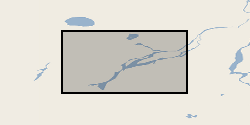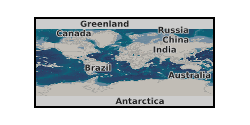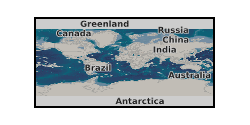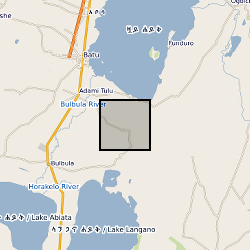Plagioclase
Type of resources
Topics
Keywords
Contact for the resource
Provided by
Years
Formats
Representation types
Update frequencies
-

Major and trace element data for plagioclase and whole-rocks from Japan sampled and filtered from the GEOROC online database (http://georoc.mpch-mainz.gwdg.de/georoc, state: 1 January 2017). The data was used to test the recently developed plagioclase porphyry indictor mineral, as described in Williamson et al. (2016, Nature Geoscience, 9: 237-241), on samples from Japan. Japan is considered a negative control as it has no known porphyry deposits, despite showing favourable geology. The data was used in Williamson B.J., Hodgkinson M., Imai A., Takahashi R., Armstrong R.N., Herrington, R.J., 2018. Testing the Plagioclase Discriminator on the GEOROC Database to Identify Porphyry-Fertile Magmatic Systems in Japan, Resource Geology, 68: 138-143.
-

Geochemical analyses of melt inclusions, host minerals, and glasses from the 2014-15 Holuhraun eruption, Iceland. Published in: Hartley ME, Bali E, Neave DA, Maclennan J, Halldorsson SA (2018) Melt inclusion constraints on petrogenesis of the 2014–2015 Holuhraun eruption, Iceland. Contrib Mineral Petrol 173:10. doi:10.1007/s00410-017-1435-0
-

Textural data and major element geochemical data for plagioclase crystallisation experiments. Data were collected 2020-2022. The aim of the experiments was to produce plagioclase crystals at a variety of sizes at low to moderate undercooling conditions (~0 < ΔT < 45 °C) and characterise their shapes. Experiments, data acquisition and processing were conducted by Dr Martin Mangler and Eshbal Geifman. This research was funded by a NERC grant to Madeleine Humphreys, Richard Brooker, Fabian Wadsworth and Alex Iveson, and by an ERC Consolidator award to Madeleine Humphreys under the European Union’s Horizon 2020 research and innovation programme (grant agreement 864923). Full details of the data analysis and interpretation can be found in Mangler et al. (2023): Melt diffusion-moderated crystal growth and its effect on euhedral crystal shapes, Journal of Petrology, doi.org/10.1093/petrology/egad054.
-

This is supporting data for the manuscript entitled 'DFENS: Diffusion chronometry using Finite Elements and Nested Sampling' by E. J. F. Mutch, J. Maclennan, O. Shorttle, J. F. Rudge and D. Neave. Preprint here: https://doi.org/10.1002/essoar.10503709.1 Data Set S1. ds01.csv Electron probe microanalysis (EPMA) profile data of olivine crystals used in this study. Standard deviations are averaged values of standard deviations from counting statistics and repeat measurements of secondary standards. Data Set S2. ds02.csv Plagioclase compositional profiles used in this study, including SIMS, EPMA and step scan data. Standard deviations for EPMA analyses are averaged values of standard deviations from counting statistics and repeat measurements of secondary standards. Standard deviations for SIMS and step scan analyses are based on analytical precision of secondary standards. Data Set S3. ds03.csv Angles between the EPMA profile and the main olivine crystallographic axes measured by electron backscatter diffraction (EBSD). 'angle100X' is the angle between the [100] crystallographic axis and the x direction of the EBSD map, 'angle100Y' is the angle between [100] crystallographic axis and the y direction of the EBSD map, and 'angle100Z' is the angle between the [100] crystallographic axis and the z direction in the EBSD map etc. 'angle100P' is the angle between the EPMA profile and the [100] crystallographic axis, 'angle010P' is the angle between the EPMA profile and the [010] crystallographic axis, and 'angle100P' is the angle between the EPMA profile and the [001] crystallographic axis. All angles are in degrees. Data Set S4. ds04.csv Median timescales and 1 sigma errors from the olivine crystals of this study. The +1 sigma (days) is the quantile value calculated at 0.841 (i.e. 0.5 + (0.6826 / 2)). The -1 sigma (days) is therefore the quantile calculated at approximately 0.158 (which is 1 - 0.841). The 2 sigma is basically the same but it is 0.5 + (0.95/2). The value quoted as the +1 sigma (error) is the difference between the upper 1 sigma quantile and the median. Likewise the -1 sigma (error) is the difference between the median and the lower 1 sigma quantile. Data Set S5. ds05.xlsx Median timescales and 1 sigma errors from the plagioclase crystals of this study. Results from each of the parameterisations of the Mg-in-plagioclase diffusion data are included: Faak et al, (2013), Van Orman et al., (2014) and a combined expression. Data Set S6. ds06.xlsx Spreadsheet containing the regression parameters and covariance matrices used in this study and in Mutch et al. (2019). Additional versions of the olivine regressions where the ln fO2 is expressed in Pa have been made for completeness. We recommend using the versions where ln fO2 is expressed in its native form (bars).
-

lectron probe analyses of the composition of plagioclase macocrysts from the 2021 eruption of the Fagradalsfjall eruption in Iceland. These were collected in profiles from rim-to-core and were designed for diffusion chronometry applications. This will be published in a article (in press in late 2022) in the journal Geology and with lead author Kahl. Analyses of a secondary standard across the many days of analytical sessions are also provided.
-

Mush eruptibility and resorption data for Mount St Helens including; - Textural data for plagioclase in crystallisation-resorption experiments - Major element geochemical data for plagioclase and glass synthesised experimentally - Major element and trace element geochemical data for plagioclase phenocrysts from Mount St. Helens volcano - Textural data for plagioclase phenocrysts from Mount St. Helens volcano
-

A single Excel spreadsheet giving augite-plagioclase-plagioclase dihedral angle populations in cumulates from the Rustenberg Layered Suite of the Bushveld Igneous Complex. A document providing the background information and location of the samples used in the study. The data have been published: Holness et al. (2017) Contributions to Mineralogy and Petrology, 172:102 doi.org/10.1007/s00410-017-1423-4
-

We collected major element, trace element and Nd isotopes of cumulate plagioclase and clinopyroxene in lower crustal gabbros from Hess Deep oceanic crust (~2°15'N, 101°30'W) to investigate the Nd isotopic heterogeneity of melts delivered to a complete section of Hess Deep oceanic crust, accreted at the fast-spreading (133 mm/yr) East Pacific Rise (EPR). These data are presented in Cooper et al. (2025) (https://doi.org/10.1130/G52872.1). Elemental maps of 58 samples were initially obtained prior to selecting a subset of 25 samples for in-situ microanalysis. We targeted the Nd isotope record of cumulate plagioclase and clinopyroxene from lower crustal gabbro samples, representing early crystallisation products of melts delivered to the crust. These samples were collected in several expeditions: Ocean Drilling Program (ODP) Leg 147; RSS James Cook cruise JC21; Integrated Ocean Drilling Program (IODP) Expedition 345 (Site U). Combined, these studies provide the most complete composite section of fast-spreading EPR crust to date (stratigraphic depth of 4350 m to 25 m). In our study, we selected 25 samples for in situ Nd isotope microanalysis, covering the range of mineralogy and textural diversity, and over the full stratigraphic depth. For a comparison to local MORB compositions, we selected a set of 13 upper-crustal sheeted dikes collected on the RSS James Cook cruise JC21. Our data reveal that the mantle is heterogeneous at the scale of melt extraction, and the crystal record from the lower crust shows greater 143Nd/144Nd heterogeneity than the overlying MORB. Hence, Pacific MORBs do not reflect the full heterogeneity of their mantle source, and some aggregation of melts occurs within the crust. Data was collected between 2020 and 2023 by George Cooper, Johan Lissenberg and Max Jansen at Cardiff University, UK, as part of NERC Grant NE/T000317/1:HiDe: A Highly Heterogeneous Depleted Upper Mantle? Mineral isotopic analyses were performed on a Thermo Scientific TRITON Plus at the Vrije Universiteit in Amsterdam. The long-term average and reproducibility (2019–2022) for the JNdi-1 standard is 0.512094 ± 0.000011 2 SD (standard deviation; n = 28) with 1011Ω resistors (used for clinopyroxene) and 0.512105 ± 0.000044 2 SD (n = 45) with four 1013Ω resistors (used for plagioclase). Full methodology can be found within the supplemental Material of Cooper et al. (2025) at https://doi.org/10.1130/GEOL.S.28485770 The DOI is a supplement to https://doi.org/10.1130/G52872.1 Methodology: https://gsapubs.figshare.com/articles/journal_contribution/Supplemental_Material_Crustal_versus_mantle-level_aggregation_of_heterogeneous_melts_at_mid-ocean_ridges/28485770?file=52665137
-

Petrological and geochemical analysis of samples from Aluto volcano, Ethiopia. Data are referenced in Gleeson et al., 2017: Constraining magma storage conditions at a restless volcano in the Main Ethiopian Rift using phase equilibria models; https://doi.org/10.1016/j.jvolgeores.2017.02.026.
-

Geochemical data has been collected on samples from new exposures of the 1883 deposits, revealed by the 2018 tsunamigenic flank collapse of Anak Krakatau, which provides improved stratigraphic context. Whole-rock data taken by X-ray Florescence shows no systematic stratigraphic correlation. Chemical data for transects across, and spot points on, plagioclase phenocrysts, including some trace element data, all obtained using Electron Probe Microanalysis (EPMA), with Backscatter electron (BSE) images of crystals, obtained using Scanning Electron Microscope, reveal complex zoning profiles. However, chemical data for transects across pyroxene phenocrysts, obtained using EPMA, show this phenocryst phase is largely unzoned. The dataset also includes chemical data for spots on Fe/Ti oxides, included on the rims of pyroxene, and obtained using EPMA. Matrix glass chemistry, obtained via EPMA, shows that the early eruptive ash is more evolved than the pyroclastic material that follows, and that there is a slight overall trend to a more homogenous, less evolved melt composition. The 1883 eruption of Krakatau was a large, cardera-forming eruption that caused approximately 36,000 fatalities. It is also the only eruption of its size to have accompanying written accounts.
 NERC Data Catalogue Service
NERC Data Catalogue Service